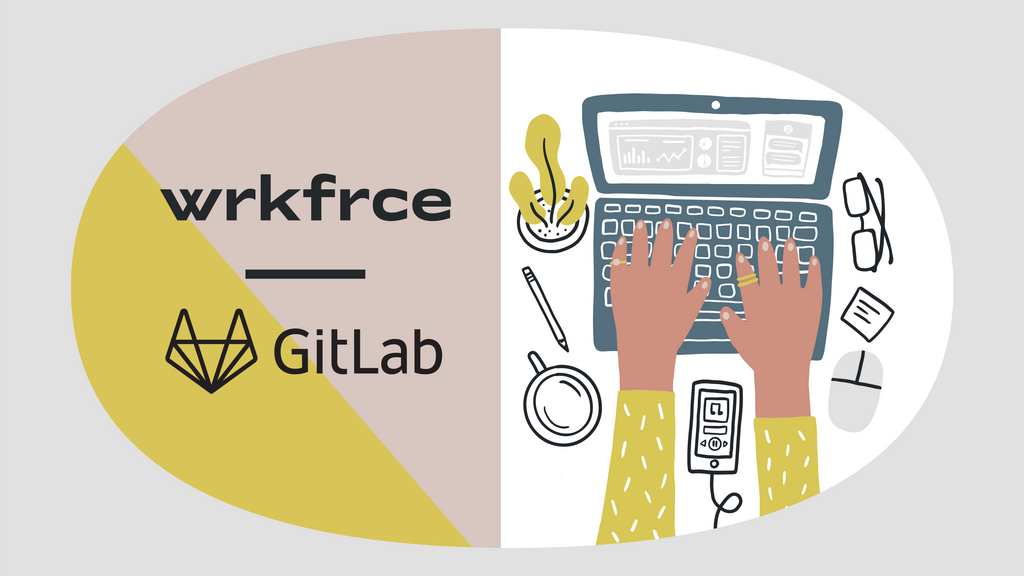Summary: GitLab’s Remote Playbook
by Sarah Archer

The global rise of reactive remote work in 2020 spawned a proliferation of playbooks published by many of the leading remote-first companies, which open-sourced the knowledge they’ve gained from years of successful fully remote operation to help other businesses follow their lead. There’s only one problem: These playbooks are loooooong. So wkrfrce has condensed them into abridged versions—CliffsNotes, if you will. Digital nomad Sarah Archer, a passionate advocate of remote and flexible work, has combed through thousands of pages of remote-first strategies to deliver the most unique, most useful, most actionable insights to help make working remotely work for you.
Since GitLab’s inception in 2011, the founders’ aim has been to create a great collaboration tool. Nearly 10 years later, GitLab offers a web-based DevOps life cycle tool that shortens developer cycle time, bridges silos, and stages to allow teams to work together better.
GitLab is now 1,300 people strong, and collaboration is not only the backbone of its product but a value that its team lives by every day.
So it’s no wonder that GitLab comes up frequently as one of the best remote companies to work for—its results-driven approach and dedication to transparency, efficiency, and inclusion helped it secure an 87 percent retention rate in 2019.
And GitLab isn’t open-source only about its product; it shares a public road map to becoming a successful remote business, which we’ll dive into here.
Documenting Everything Is the Key to Remote Work
GitLab recognizes that human memory isn’t perfect and that documenting everything the company does contributes directly to its efficiency.
It’s second nature for humans to trust other humans more than they trust written words; however, if you empower everyone to contribute to a single source of truth, referring to that source becomes more natural. Here are some of the processes that have enabled GitLab’s success and that other companies can use to adopt text-based documentation.
- Establish a company-wide handbook
GitLab consistently refers to its public-facing handbook as the “single source of truth.” This single reference not only saves time by avoiding reoccurring questions but also minimizes confusion for a growing team. - Develop a communications plan
To support work more efficiently, GitLab encourages developing an asynchronous communication plan. At a high level, GitLab does so by writing everything down, encouraging feedback, and enforcing a “you type it, you own it” policy. - Make goals visible to all
To be transparent about how each team is progressing, GitLab outlines quarterly goals for the entire company to reference. - Prioritize documents over water-cooler chats
Because the fact that GitLab team members work in varying time zones, leaving someone out of a conversation can happen too easily. GitLab combats that pitfall by writing all important work discussions—in well-organized documents—so nothing gets lost. - Make meetings optional
GitLab strives to avoid holding a meeting by default, instead giving employees the power to decide if they want to join live. If you’d like to follow GitLab’s lead, record every meeting and create an agenda with an attached Google Doc to write down discussions, decisions, and action points. - Provide context for everything
Despite the time commitment needed to add context about why a team has made certain choices, doing so will help team members now and in the future understand what went into a decision. This approach is especially important, GitLab notes, as employees come and go and, with them, any memory of the situation surrounding the decision. - Embrace iteration
Rather than writing a full plan, GitLab advises, write the first step. Then be open to what is and isn’t working, and make changes in real time.
Embracing iteration is essential at every level. Sid Sijbrandij, cofounder and CEO of GitLab, realized success through working in iterations in many ways. He said, “Don’t work harder or longer hours. Just give yourself a really tight deadline and see what you can do in that time.”
Let Values Drive Your Company Culture
Gitlab’s core values are collaboration, results, efficiency, diversity, inclusion and belonging, iteration, and transparency. To continuously nurture company culture and team morale, GitLab suggests doing the following:
- Intentionally reinforce values
GitLab constantly reinforces its core values, beginning with hiring and onboarding, and uses them as criteria for promotions, discretionary bonuses, annual compensation reviews, and, sometimes, underperformance reviews. - Promote informal communication
People who have friends at work are more likely to like their job, but companies should not expect informal communication to occur naturally. Instead, they should design an atmosphere in which team members feel comfortable talking about topics outside work. GitLab suggests Donut to select a coffee-chat partner; you can also try coworking calls, dedicate Slack channels to hobbies, or hold virtual social hours. - Be proactive about mental health
In a remote setting, burnout, isolation, and anxiety can easily go unrecognized. To protect its workers’ mental health, GitLab offers professional assistance and ongoing learning opportunities and doesn’t celebrate long working hours. - Prevent burnout
In a similar vein, GitLab actively pushes employees to set boundaries between work and home, to take a vacation or a mental health day, and to recognize the signs that say, Time to take a break! - Leverage videos for face-to-face
While meetings aren’t mandatory at GitLab, they encourage casual video calls to help remote team members feel connected with other employees.
Instill Remote-Work Best Practices from Day One
Not everyone is comfortable entering a remote work environment, but if managers know how to be patient, understanding, and positive, their team can thrive. GitLab teaches its managers to steer their direct reports toward the right resources, values, and remote-work best practices early on, by doing the following:
- Hire great leadership
Be strategic about whom you hire—the leadership team not only sets the tone of the workplace but also identifies challenges and finds solutions. GitLab leaders have remote work experience, so they can serve as resources and thoughtful decision makers for the business. - Minimize tool stack
Remote companies boast about their favorite tools, but GitLab emphasizes the importance of stripping a tool stack to only what you need. For GitLab, it’s Google Docs, Zoom, Slack, and GitLab (the product). - Promote a dedicated workspace
A work-only zone enables workers to leave it behind after working hours. GitLab recommends that everyone create such a space and then equip it with an ergonomic chair, desk, and footrest setup, along with other productivity-enhancing equipment like soundproof headphones, additional monitors, and an external keyboard and mouse. - Promote transparency outside work
Working remotely means you may be surrounded by people who are not your colleagues. GitLab encourages its remote workers to be clear with family, friends, or roommates about the importance of uninterrupted work time. - Be open to change
For some, routine is everything. But working remotely allows for experimenting with peak hours. GitLab’s playbook includes the concept of a nonlinear workday, which encourages employees to align their work hours with their most productive times. And, GitLab reminds everyone, it’s a process. If a new routine isn’t working, change it again.
Invest in a Multipurpose Remote Collaboration Tool
The GitLab team always iterates the importance of documentation, but that means having the right tools. GitLab the company uses GitLab the product for intracompany collaboration.
Whether or not you opt to invest in the same, the company gains the following benefits from its product:
- Real-time documentation
Avoids a cluttered, reply-all email thread; allows users to tag/be tagged, comment, and document in one shared place. - Categorization system
Provides high-level visibility of work done across teams using labels for different stages—for example, “planning,” “in progress,” and “complete.” - Visualize long-term strategy
Tracks project progress against the assigned completion date through a feature that lets users visualize every step. - Treat copy like code
Documents versions so everyone knows who made changes and when—essential when working with a team in multiple time zones.
The numbers tell the story: GitLab’s 2020 Remote Work Report found that 86 percent of respondents “believe remote work is the future of work.” And GitLab’s best practices can help that future be collaborative, productive, and bright.
See our remote playbook series to discover how other companies are approaching remote work.









